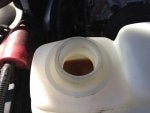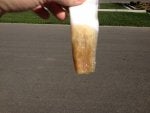Had my injector cups replaced last week. Basically, all the coolant in the system was mixed with fuel. The problem was so bad, the coolant recovery tank had a crack in the top of it, and the fumes from fuel/coolant mix would waft into the HVAC system while driving and make the interior smell very strong.
Bear in mind, I have already done the fuel filter 3 o-ring repair, it was successful and also, I carefully pressure-washed the valley and top of the motor, and rinsed the smells off, and it's dry as a bone. So I know the smells I am describing are the fuel-coolant mix from the leaking injector cups.
Since they also replaced the coolant tank, and flushed the system out about three times, Grant at Grant's Garage warned me that the circulating coolant would still find leftover bits of fuel in the system and bring it to the high point, which is the coolant recovery tank. He was right. But I am having to devise my own way to deal with it... since even if you suck out or wick off the fuel in the top layer of coolant using a rag, the smell is still there on the inside plastic of the tank, and amazingly, you can still smell it even with the cap on, air-tight.
I will take some pictures this weekend, but what I am doing is putting a large needle nose vice grip on the lower hose as a clamp, and removing the upper small hose to the recovery tank and simply removing the tank itself and dumping the contents. As I pull it up and off the big lower hose I just jam a rag onto the bottom nipple to keep it from dumping into the engine bay. Even with the tank empty, it smells horrible and this smell would make it into the cabin. I then wash the tank out with soap and water, rinse thoroughly and re-install and re-fill it back up to the cold line. This process usually spills some fuel-coolant in the engine bay, so I spray that off after buttoning up, as well.
I also figured that since there's a heater core in the rear HVAC system, I'd better run it at full hot setting for a few days, to circulate the diesel fuel out of the heater core. Not sure if the heater core has a valve, but if it does, running it at full-blast will definitely open it. In fact, I am doing it in the front HVAC as well. Now, after a couple of days of driving with the heat on full, and some windows open, the rear HVAC compartment does not smell like fuel anymore. I don't think there's a leak back there, because as I mentioned; the smell of the fuel just permeates right thru the rubber, or around the seals. Now I don't smell much at all back there.
It's been a full 7 days since I got it back, and as of last night, there still was a 3/8" thick layer of fuel scum in the tank. I imagine I'll be at this for awhile. The smell is minimized, but you can still smell fuel/coolant in the morning after the Ex has been sitting in a closed garage all night, and if you walk up and check out the coolant recovery tank cap, it is the source of the smell.
I wish there was a way to run a solvent in the coolant system to pull the fuel off the walls inside the hoses and water jacket.
Bear in mind, I have already done the fuel filter 3 o-ring repair, it was successful and also, I carefully pressure-washed the valley and top of the motor, and rinsed the smells off, and it's dry as a bone. So I know the smells I am describing are the fuel-coolant mix from the leaking injector cups.
Since they also replaced the coolant tank, and flushed the system out about three times, Grant at Grant's Garage warned me that the circulating coolant would still find leftover bits of fuel in the system and bring it to the high point, which is the coolant recovery tank. He was right. But I am having to devise my own way to deal with it... since even if you suck out or wick off the fuel in the top layer of coolant using a rag, the smell is still there on the inside plastic of the tank, and amazingly, you can still smell it even with the cap on, air-tight.
I will take some pictures this weekend, but what I am doing is putting a large needle nose vice grip on the lower hose as a clamp, and removing the upper small hose to the recovery tank and simply removing the tank itself and dumping the contents. As I pull it up and off the big lower hose I just jam a rag onto the bottom nipple to keep it from dumping into the engine bay. Even with the tank empty, it smells horrible and this smell would make it into the cabin. I then wash the tank out with soap and water, rinse thoroughly and re-install and re-fill it back up to the cold line. This process usually spills some fuel-coolant in the engine bay, so I spray that off after buttoning up, as well.
I also figured that since there's a heater core in the rear HVAC system, I'd better run it at full hot setting for a few days, to circulate the diesel fuel out of the heater core. Not sure if the heater core has a valve, but if it does, running it at full-blast will definitely open it. In fact, I am doing it in the front HVAC as well. Now, after a couple of days of driving with the heat on full, and some windows open, the rear HVAC compartment does not smell like fuel anymore. I don't think there's a leak back there, because as I mentioned; the smell of the fuel just permeates right thru the rubber, or around the seals. Now I don't smell much at all back there.
It's been a full 7 days since I got it back, and as of last night, there still was a 3/8" thick layer of fuel scum in the tank. I imagine I'll be at this for awhile. The smell is minimized, but you can still smell fuel/coolant in the morning after the Ex has been sitting in a closed garage all night, and if you walk up and check out the coolant recovery tank cap, it is the source of the smell.
I wish there was a way to run a solvent in the coolant system to pull the fuel off the walls inside the hoses and water jacket.








